Carbon sequestration and innovative carbon removal systems and technologies from around the web.
MIT Review: A stealth effort to bury wood for carbon removal has just raised millions
A stealth effort to bury wood for carbon removal has just raised millions | MIT Technology Review
By James Temple
December 15, 2022
Kodama has raised more than $6 million from Bill Gates’ climate fund and other investors, as it pursues new ways to reduce wildfire risks and lock away carbon in harvested trees.
A California startup is pursuing a novel, if simple, plan for ensuring that dead trees keep carbon dioxide out of the atmosphere for thousands of years: burying their remains underground.
Kodama Systems, a forest management company based in the Sierra Nevada foothills town of Sonora, has been operating in stealth mode since it was founded last summer. But MIT Technology Review can now report the company has raised around $6.6 million from Bill Gates’s climate fund Breakthrough Energy Ventures, as well as Congruent Ventures and other investors.
In addition, the payments company Stripe will reveal on Thursday that it’s provided a $250,000 research grant to the company and its research partner, the Yale Carbon Containment Lab, as part of a broader carbon removal announcement. That grant will support a pilot effort to bury waste biomass harvested from California forests in the Nevada desert and study how well it prevents the release of greenhouse gases that drive climate change.
It also agreed to purchase about 415 tons of carbon dioxide eventually sequestered by the company for another $250,000, if that proof-of-concept project achieves certain benchmarks.
“Biomass burial has the potential to become a low-cost, high-scale approach for carbon removal, though there is a need for further investigation into its long-term durability,” said Joanna Klitzke, procurement and ecosystem strategy lead for Stripe.
For the last several years, Stripe has pre-purchased tons of carbon dioxide that startups aim to eventually draw out of the air and permanently sequester, in an effort to help build up a carbon removal industry. It has also helped establish a different model for counteracting corporate climate emissions that goes beyond simply purchasing carbon credits from popular offsets projects, such as those that involve planting trees, which have come under growing scrutiny.
A handful of research groups and startups have begun exploring the potential to lock up the carbon in wood, by burying or otherwise storing tree remains in ways that slow down decomposition.
Trees are naturally efficient at sucking down vast amounts of carbon dioxide from the air, but they release the carbon again when they die and rot on the ground. Sequestering trees underground could prevent this. If biomass burial works as well as hoped, it may provide a relatively cheap and easy way to pull down some share of the billions of tons of greenhouse gas that studies find may need to be removed to keep global temperatures in check in the coming decades.
But until it’s been done on large scales and studied closely, it remains to be seen how much it will cost, how much carbon it could store, and how long and reliably it may keep greenhouse gases out of the atmosphere.
Dead wood
Forest experts have long warned that decades of overly aggressive fire suppression policies in the US have produced dense, overgrown forests that significantly increase the risk of major conflagrations when wildfires inevitably occur. Climate change has exacerbated those dangers by creating hotter and drier conditions.
Following a series of devastating fire years across the West, a number of states are increasingly funding efforts to clear out forests to reduce those dangers. That includes removing undergrowth, cutting down trees, or using controlled burns to break up the landscape and prevent fires from reaching forest crowns.
States are expected to produce more and more forest waste from these efforts as climate change accelerates in the coming years, says Justin Freiberg, managing director of the Yale Carbon Containment Lab, which has been conducting field trials exploring a number of “wood carbon containment” approaches under different conditions for several years.
But today, the harvested plants and trees are generally piled up in cleared areas and then left to rot or deliberately burned. That allows the carbon stored in them to simply return to the atmosphere, driving further warming.
Kodama hopes to address both the wildfire dangers and the emissions challenge. The company says it’s developing automated ways of thinning out overcrowded forests that will make the process cheaper and faster (though it’s not yet discussing this part of the business in detail). After stripping off the limbs from trees too small to be sold for timber, they’ll load them into trucks and ship them to a prepared pit.
The key will be to ensure that what the company refers to as a “wood vault” keeps out oxygen and water that would otherwise accelerate decomposition and prevents greenhouse gases from leaking out.
In the field effort with Yale researchers, expected to begin in the third quarter of next year, the company intends to create a burial mound in the Nevada desert that’s seven yards high, three yards deep, and 58 yards long and across.
They plan to cover the biomass with a geotextile liner and then bury that under soil and a layer of native vegetation selected to absorb moisture. Given the region’s dry conditions, this will create a contained system that prevents “agents of decomposition from acting on the buried wood mass,” ensuring that the carbon stays in place for thousands of years, says Jimmy Voorhis, head of biomass utilization and policy at Kodama.
Freiberg adds that they’ll also leave wood exposed at the site and create smaller side vaults designed in different ways. The teams will continue to monitor them and compare decomposition rates and any greenhouse-gas leakage for years. The teams expect to be able to extrapolate long-term carbon storage estimates from that data, along with other studies and experiments.
Burial costs
Other startups and research efforts are taking different approaches to the problem.
The Australian company InterEarth believes that allowing trees to soak up salty groundwater before burying them will effectively pickle the wood, preserving it for extended periods.
The Carbon Lockdown Project, a public benefits corporation founded by University of Maryland professor Ning Zeng, has proposed creating pits that are lined with clay or other materials with low permeability.
In a paper this year, Zeng and a colleague also highlighted a number of other potential approaches, including storing biomass in frozen sites, underwater, or even in above-ground shelters. His earlier work found that harvesting and storing wood could potentially remove several billion tons of carbon dioxide a year at a cost of well below $100 a ton.
But there are still many unknowns.
“We have to recognize that the science of wood harvesting and storage is still evolving,” says Daniel Sanchez, chief scientist for biomass carbon removal and storage at Carbon Direct, which evaluates carbon removal efforts and corporate climate plans. “Most importantly, our understanding of what drives or doesn’t drive decomposition of wood needs to be refined.”
On top of that, residents and environmental groups are often opposed to forest thinning. Sawing down trees and removing them from the steep slopes of dense forests is a laborious and costly process that will be difficult to automate effectively. Hauling around bulky tree remains and digging big holes is also expensive and requires a lot of energy.
The climate emissions produced by removing, transporting, and burying wood will need to be carefully tallied and counted against the total carbon stored.
Finally, there’s the question of acquiring the necessary waste biomass.
A 2020 study by Lawrence Livermore National Lab found plenty to go around for these sorts of purposes today, estimating that 56 million “bone dry” tons of waste biomass are produced each year just in California from agriculture, logging, fire prevention, and other activities. (Wood is about 50% carbon by mass.)
But demands for it are set to rise as startups like Kodama, Mote Hydrogen, and Charm all seek out these sources for various biomass-related carbon removal efforts and the world races to achieve ambitious climate targets.
There’s some risk that eventually all these efforts could create perverse incentives to remove more trees or agricultural material than necessary for fire prevention or healthy for ecosystems. After all, removing biomass also reduces the levels of nutrients that forests and farms get from rotting plants.
Kodama says it has done economic and carbon assessments for its full process. It’s confident that it can achieve costs below $100 a ton of carbon, and estimates that emissions from the pilot project will only reduce the net amount of carbon ultimately sequestered by about 15%.
Merritt Jenkins, the company’s cofounder and chief executive, says they plan to earn revenue from their forest thinning work, as well as by selling usable timber and carbon credits from its burial projects.
But Yale’s Freiberg stresses that the critical mission of the moment is to use that Stripe grant to help answer these “big scientific questions around burial biomass … and demonstrate that this is indeed a solution worth backing.”hide
by James Temple
NOVA: Natural Carbon Sequestration
NOVA: Polar Extremes
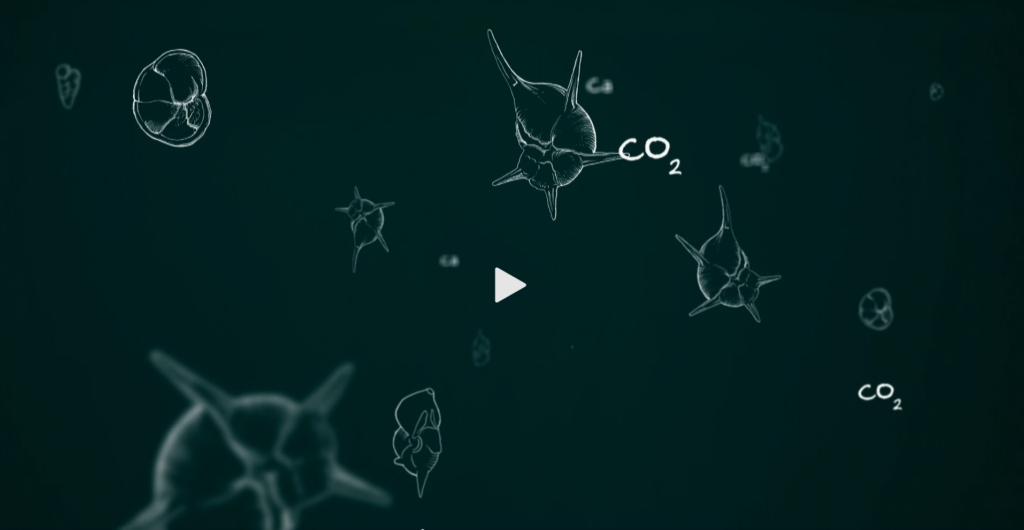
Pattrn: Soil Health for Planet Health
Direct link: https://fb.watch/oOUVuxsZoA/
Meet the farmers and ranchers working to improve the health of our soil and sea to save their livelihoods – and our planet. https://www.pattrn.com/
Watch “To Which We Belong” on Pattrn streaming.
Drought Reveals History on Lakebed
Drought Reveals History on Lakebed
KEVIN LOLLAR THE ASSOCIATED PRESS

Direct Link: Drought reveals history on lake bed
IMMOKALEE — From a distance, the brown object near the bank of Lake Trafford looks like a log, or maybe a big alligator.
Close up, though, it becomes identifiable as a large section of a dugout canoe, possibly more than 1,000 years old.
As lake levels have dropped during the ongoing drought, normally submerged areas have become dry. Ten canoes, long buried in the sand, have been exposed.
“They started showing up a couple of months ago, but I wanted to verify what they were,” said Ski Olesky, owner of the Lake Trafford Marina. “That’s why I didn’t say anything. Now, the water is coming back up, and pretty soon, you won’t be able to see them.”
Archaeologist George Provenzali of Janus Research in Tampa was called in to measure the canoes and take samples for radiocarbon dating to decipher their age and to determine what kind of trees they are from.
The largest canoe fragment was almost 14 feet long; some seem to be cypress, others pine. Radiocarbon dating should be complete within two months, Provenzali said.
“The dates will probably vary, and until we get the data back, we can’t say much,” Provenzali said. “But the dugouts are very old. Those things are amazing: You take a sample, and it looks like the trees were cut yesterday.”
Dead plant material generally breaks down quickly, but the canoes had been buried in anaerobic sediment without oxygen where organisms that cause decomposition cannot live.
Dredging activity at the lake and natural wave action have uncovered the canoes.
In the spring and summer of 2000, a drought in northern Central Florida lowered water levels in Newnan’s Lake east of Gainesville, and archaeologists discovered 87 500- to 5,000-year-old canoes. Florida’s oldest canoes, discovered at DeLeon Springs in Volusia County, are 6,000 years old.
“Canoes of any sort are very rare in South Florida,” said Bill Marquardt, curator in archaeology at the Florida Museum of Natural History in Gainesville.
“Many more are known in the lakes in North Florida. Anytime a water-logged canoe is found in South Florida, it’s something we can learn from.”
At the time of contact with Europeans in the early 16th century, all of South Florida was dominated by the Calusa Indians, a fishing culture whose population centers were along the coast at such places as Pineland on Pine Island and Mound Key in Estero Bay.
Researchers do not know whom the Trafford canoes belonged to.
“Historically, South Florida was under the control of the Calusa,” Marquardt said. “So it may have been other groups subservient to the Calusa. We don’t know the tribal names.” He said they might have been made by the Muspa or by related Indians from the Lake Okeechobee area.
There are no plans to remove the canoes from the lake, Provenzali said.
“If we retrieve them, in a year or two, they’ll disintegrate,” he said. “We’re hoping the rain comes and covers them, and they can be preserved for hundreds or thousands of years.”
This is not the first time ancient canoes have been spotted at Lake Trafford, said marina mechanic and guide Bubba Blaylock: During a dry spell a few years ago, some canoes were exposed, but then rains raised the lake level and water covered them.
“Over the years, I’ve heard stories about people’s grandfathers who’d say, ‘Hey, there are canoes in Lake Trafford,'” Blaylock said. “Others would say, ‘No way, I’ve seen the lake low, and there aren’t any canoes.’ But I tell you: I wouldn’t cross this lake in a canoe like this, not with all the alligators out there. Maybe the Indians had more influence with their young men, but I would have had to say no.”
7,000-Year-Old Native American ‘Bog Burial’ Found Off the Coast of Florida
7,000-Year-Old Native American ‘Bog Burial’ Found Off the Coast of Florida
Experts have identified the remains of at least six individuals, and suspect there are many more bodies to be found
March 8, 2018
Direct Link: 7,000-Year-Old Native American ‘Bog Burial’ Found Off the Coast of Florida | Smithsonian
Thousands of years ago, ancestors of Florida’s indigenous people buried their dead in shallow, peat-bottomed ponds. As sea levels rose, these watery graveyards were submerged by the Gulf of Mexico. But as Megan Gannon reports for National Geographic, the Florida Department of State announced last week that it had unearthed an Early Archaic Native American burial ground off the coast off Manasota Key. Archaeologists have thus far identified the remains of six individuals, but they suspect that many more bodies may lie beneath the sea floor.
The ground-breaking discovery was made in 2016 by a diver who was searching for prehistoric shark teeth—a popular pastime on the Gulf beaches around Venice, Florida. But instead of shark teeth, the diver found a jawbone, with a molar still attached. He brought the relic to the attention of Florida’s Bureau of Archaeological Research, which confirmed that the jawbone had come from a human.
A team of underwater archaeologists, led by bureau supervisor Ryan Duggins, subsequently set out to explore the site where the bone had been found. “As soon as we were there it became clear that we were dealing with something new,” Duggins tells Gannon. He quickly discovered a broken arm bone, a collection of carved wooden stakes and three separate skull fragments. The team returned to the site in 2017 and found more human bones and wooden stakes, along with textile fragments.
In a statement, the Florida Department of State said that the burial ground has been dated to around 7,000 years ago. At that time, sea levels were much lower than they are today, creating the “small inland freshwater pond” there. Duggins tells Gannon that when ancient indigenous people buried their dead in ponds such as this one, they hammered sharpened stakes into the pond bed, surrounding the body with wooden markings that protruded out of the water.
Though the newly discovered graveyard was eventually covered by deeper waters, the peat bottom remained intact. “Peat slows the process of organic decay,” the Florida Department of State explains in its statement, “which allowed the site to stay well preserved.”
Officials note in the statement that it is “exceedingly rare” to find submerged offshore prehistoric burial sites, especially in North America. So-called “bog burials” are more frequently associated with regions in Northern Europe, where remarkably intact remains have been found. But the newly announced discovery is not the first peat graveyard be unearthed in Florida. Back in the 1980s, archaeologists were able to excavate 168 “bog bodies” at a pond in near Cape Canaveral, which is known as the “Windover” site. Some of the remains were so well-preserved that their brains survived to modern times.
As Rafi Letzer of Live Science points out, the new discovery off Manasota Key suggests the region may hold other unexplored Native American burials that have managed to survive over millennia, withstanding natural forces like erosion and hurricanes. For now, Florida archaeologists are working to dry and desalinate the bones, and they hope the remains will lead to new insights about Florida’s prehistoric populations.
Officials are also taking pains to ensure that the remains are treated respectfully. The site of the graveyard is protected under Florida law, and it is illegal to remove or disturb any artifacts in the area. Duggins tells Gannon of National Geographic that he is consulting with Seminole Tribe of Florida about the treatment of the bones, and Florida officials plan to send a nationwide notice to Native American tribes who might want to claim the remains under the Native American Graves Protection and Repatriation Act.
“As important as the site is archaeologically, it is crucial that the site and the people buried there are treated with the utmost sensitivity and respect,” Timothy Parsons, director of Florida’s Division of Historical Resources, said in the Department of State’s press release. “The people buried at the site are the ancestors of America’s living indigenous people. Sites like this have cultural and religious significance in the present day.”
The Global Woody Detritus Decomposition Study
Direct Link: andrewsforest.oregonstate.edu/sites/default/files/lter/research/component/carbon/global_w_08.htm
The Global Woody Detritus Decomposition Study
Prepared by: Mark E. Harmon
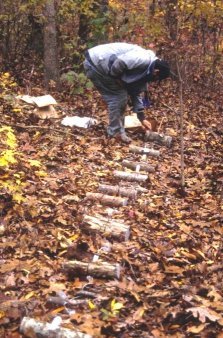 |
Woody detritus is an important, but overly neglected part of forested ecosystems. To date its role in carbon dynamics has received little attention at either the local or global scale, but recent studies indicate much of the C efflux associated with land-use change results from woody detritus combustion and decomposition. Unfortunately the decomposition rates used in these analyses do not have a firm empirical or conceptual basis. It is quite clear that major uncertainties about the amounts of carbon released by forest disturbances and the total carbon stores of forest ecosystems will not be resolved until woody detritus decomposition rates are either measured directly or predicted using a mechanistic basis.
To provide empirical data we are now measuring rates at 14 sites that cover the entire range of climatic conditions in which forests grow. These include nine sites dominated by conifers (Andrews-OR, Ashland RNA-OR, Cascade Head-OR, Fraser-CO, Medicine Bow-WY, Mount Rainier-WA, Pringle Falls-OR, Sequoia-CA, Wind River-WA), one conifer-hardwood mixed site (St. Petersburg, Russia), a temperate hardwood dominated site (Chapel Hill, NC) and three Mexican tropical hardwood sites (Los Tuxtlas, Puerto Morelos and Nobeck). Tree genera available at these sites include:
| Alnus, Abies,Betula, Blomia, Brosium, Bursera,Carya, Calocedrus, Cecropia,Darbeygia, Dendropanax, Dialium, Dipholis,Fagus, Ficus,Heliocarpus,Juniperus,Liquidambar, Liriodendron,Manlikaria, Myciantheses,Nectandra,Orthion,Picea, Pinus, Populus, Pseudolmedia, Pseudotsuga,Quercus,Robinsolla,Sabal, Salix, Sassafrass, Sorbus, Stemmadenia, Swietenia,Tabebuia, Talisia, Thuja, and Tsuga. |
This gives us over 60 species to examine.
We are examining the following:
1) The interaction between species decay resistance and size. We hypothesize that the species with the most decay resistant heartwood will have the greatest decrease in decomposition rate with increases in diameter.
2) The interaction of macroclimate and species. We hypothesize that as the macroclimate becomes more favorable to decomposition, the species with the least decay resistance have the greatest response.
3) The interaction between macroclimate, size, and position of the pieces. Based on our prior observations we hypothesize that under the driest macroclimate the smallest, suspended material decomposes slowest, but under the wettest macroclimatic conditions the largest downed material decomposes the slowest.
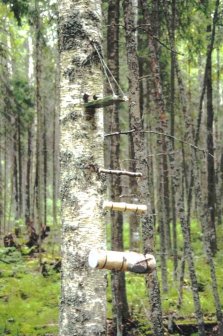
For each site a range of piece sizes from 1 cm diameter to as large as is available is being used to determine decomposition rates. We use size classes on a logarithmic scale (i.e., 1, 2, 4, 8, 16, 32 cm). In the species related experiments (1 and 2 above), the least- and most-decay resistant species available at each site were placed on the surface of the forest floor under closed canopies. In the macroclimate, size and position interaction experiment we placed pieces so that some are suspended off the forest floor, some are in contact with it, and some are buried. Sampling intervals depends on the site; in tropical sites samples will be collected at 6 month to 1-year periods and at the other sites 1-2 year intervals are employed.
To set up the studies of wood <15 cm in diameter we cut fresh branch material into lengths approximately 10 times the diameter of the size-class. After determining the fresh weight, subsamples were used to determine the initial moisture content, the cut ends of each piece will be sealed with neoprene or latex paint, and numbered aluminum tags attached with UV resistant cable ties. Pieces that were buried are wrapped in 1 mm nylon mesh to aid in recovery. Suspended pieces are held off the ground by means of a ladder-like arrangement of nylon strings hung from tree boles.
For wood >15 cm in diameter we sampled the least and most decay resistant species at a minimum. Our primary approach in these extensive studies is to use the chronosequence method to estimate the mean rate of decomposition. Dates of log formation are taken from long?term permanent plot records, tree scars, and other dating methods. We estimate fragmentation losses by comparing current volume to the original based on DBH at time of death. Sampled logs are “dissected” using a chainsaw. The depth of staining, advanced decay, and extent of termite galleries are noted, and 3 to 4 cross-sections are removed to provide samples for density, volume of insect galleries, C chemistry and N content. Density is determined from the volume and weight of the entire cross-section in the field and removing subsamples to determine moisture content. While the chronosequence method is not as precise as a time series, it provides good preliminary estimates of decomposition rates. We are increasing the precision of these estimates by resampling the logs in these chronosequences to produce a hybrid between time series and chronosequence methods (Harmon et al. 2000). Depending on the site, a 3 to12 year period between sampling times of logs has occurred, long enough for there to be a detectable change in mass.
Preliminary Results
An example of this study comes from North Carolina. In 1996, a long-term experiment to determine the decomposition rate of wood was established in forests of the North Carolina Botanical Garden, just after Hurricane Fran had passed through. Two species, Carya tomentosa and Quercus alba, were examined to see trend in mass loss over time. Each year various sized pieces of wood ranging from 1 to 8 cm diameter have been removed, oven dried and then weighed to determine the mass remaining (Figure 1). Mass loss has been steady throughout the experiment for these two species; however, the first year appeared to be slower than the sequent ones. This lag in decomposition was probably caused by the time it took decomposer fungi to colonize the wood. We anticipate rates of decomposition of species with decay-resistant heartwood to eventually slow as the experiment progresses.
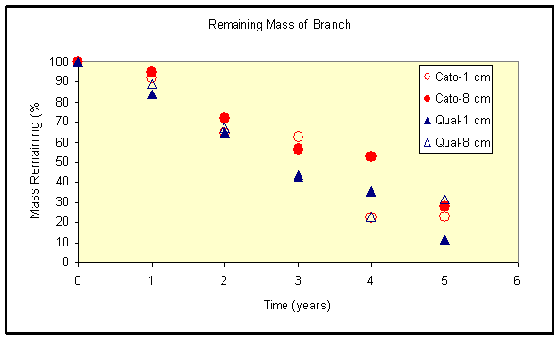 | Figure 1. Changes in mass remaining as wood decomposition proceeds at North Carolina Botanical Garden. |
Not all wood decomposes at the same rate, and differences associated with the chemical properties of various species can have a major influence. A total of eleven species were examined, with Acer rubrum, Carya tomentosa, Fagus grandifolia, Lirodendron tulipifera, Liquidambar styraciflua, Quercus alba, and Quercus rubra having at little as 15% of their mass remaining after 4 years (Figure 2). In contrast, Juniperis virginiana and Sasafrass albidum had over 40% of their mass remaining after the same period. The latter two species have very decay-resistant heartwood with high concentrations of fungitoxic compounds. Pinus echinata and P. taeda, both with resins in their heartwoods are intermediate between these two groups of species.
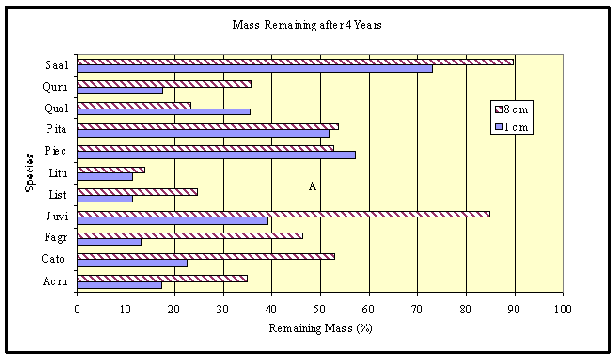 | Figure 2. Differences in species observed in North Carolina Botanical Gardens wood decomposition experiment. |
Intuitively it makes sense that larger diameter wood would take longer to decompose than small pieces. There is some evidence for this effect, although it is not as profound as one would expect for some species (Figure 3). For example, for species with little decay-resistant heartwood, such as C. tomentosa, L. tulipifera, and Q. alba, there is a slight increase in mass remaining at 4 years as piece diameter increases. In contrast, for species with decay-resistant heartwood, such as J. virginiana, the mass remaining increases dramatically as diameter increases.
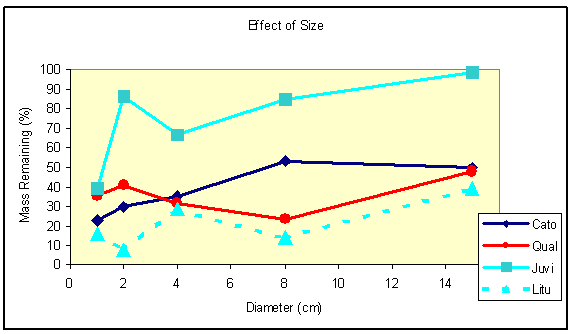 | Figure 3. Change in mass remaining after 4 years in response to piece diameter. |
Hurricane Fran added dead wood to many microclimates ranging from suspended in the air to placed on the soil surface to in the soil. In the North Carolina climate, suspended wood dries faster than wood on the soil surface or wood in the soil. This is reflected in the mass remaining after 4 years, with suspended wood having the slowest decomposition (Figure 4). Wood decomposing on the soil surface or within the soil itself were quite similar, although we expect to see local site differences as one Mason Farm site has extremely moist samples that might slow decomposition because of waterlogging.
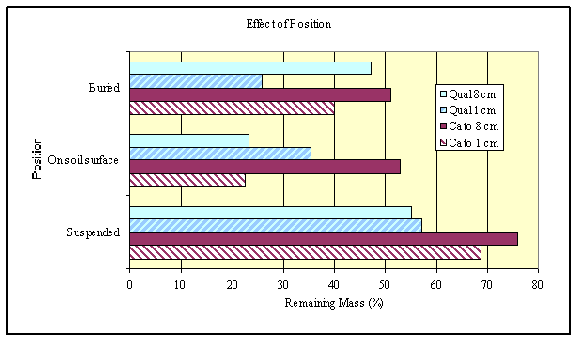 | Figure 4. Effect of position of decomposing wood relative to the soil surface on mass remaining after 4 years of decomposition. |
We have also been using these data and those from the literature to estimate the store of dead wood at the global-level. In recent years, methods to study the size and dynamics of these detritus pools have been developed and applied to various ecosystems. Despite an increase in plot-level efforts, no reliable inventory-based estimates exist at the regional, national, or global scales. We used a series of complementary methods to estimate potential steady-state and actual stores at regional to global scales. These include: (1) correction and conversion factors for incomplete inventories, (2) dead:live wood expansion factors, (3) predictions of steady-state stores from input:decomposition rate ratios, and (4) adjustments to include disturbance regimes (Harmon et al. 2001). These methods indicate that global stores of carbon in woody detritus could be 114 to 157 Pg in the absence of disturbance, 131 to 148 Pg with natural disturbance, and 114 to 129 Pg after pre-1950’s deforestation is considered. These estimates of woody detritus stores are quite crude, but they strongly indicate several points. Considerable woody detritus is present at the global level, with the bulk of it stored in evergreen forests. Globally these estimates exceed those for surface litter (50-60 Pg C) and are roughly half of that estimated for peat. Although smaller than the commonly accepted store for soils (“1500 Pg C), woody detritus is highly sensitive to natural disturbance and management by humans. This analysis indicates better inventories of dead woody detritus and measurement of its dynamics would considerably improve the overall understanding the role of carbon stores in the terrestrial biota.
Future work
We will be continuing to maintain these experiments, seeking additional funding for this effort. In addition we would like to establish experiments in environments drier than those capable of supporting closed forests (e.g., woodlands).
References
Harmon, M. E.; Krankina, O. N.; Yatskov, M.; Matthews, E. 2001. Predicting broad-scale carbon stores of woody detritus from plot-level data. In: Lal, R.; Kimble, J. M.; Follett, R. F.; Stewart, B. A., eds. Assessment methods for soil carbon. Boca Raton, FL: Lewis Publishers/CRC Press LLC: 533-552. (Pub No: 2806)
Harmon, M. E., O. N. Krankina, and J. Sexton. 2000. Decomposition vectors: A new approach to estimating woody detritus decomposition dynamics. Canadian Journal of Forest Research. 30: 74-84. (Pub No: 2598)
PRIMER: 45Q TAX CREDIT FOR CARBON CAPTURE PROJECTS
Direct Link: 45Q-primer-Carbon-Capture-Coalition.pdf
What is the Section 45Q Carbon Capture Tax Credit?
Section 45Q of the US tax code provides a performance-based tax credit for
carbon management projects which capture carbon oxides (carbon dioxide and its
precursor, carbon monoxide) from eligible industry and power facilities, as well as
directly from the atmosphere.
The 45Q tax credit can be claimed when an eligible project has:
• securely stored the captured carbon dioxide (CO2) in appropriate geologic
formations, including saline or other geologic formations or oil and gas fields; or
• reused the captured CO2 or its precursor carbon monoxide (CO) as a feedstock to
produce low embodied carbon products such as fuels, chemicals, and building
materials.
To claim the tax credit taxpayers must successfully demonstrate secure geologic
storage of captured or reused carbon. This occurs through robust and transparent
monitoring, reporting, and verification of the geologically stored CO2, or lifecycle
analysis (LCA) of the reused carbon through processes established by the US
Department of Treasury and the Internal Revenue Service and overseen by the US
Environmental Protection Agency and Department of Energy.
Fiddling while Earth burns: The UN’s dire warning about climate change inaction
Direct Link: Climate change inaction must be stepped up, UN warns – Chicago Sun-Times
Fiddling while Earth burns: The UN’s dire warning about climate change inaction
The United Nations says only about 10 years remain to drastically beef up efforts to address global warming. World governments aren’t stepping up.
By CST Editorial Board Oct 27, 2024, 11:17am EDT

Ten years.
That’s about how much time the United Nations says is left to substantially change policies so the Earth can avoid the worst effects of climate change.
And how have world governments been doing in the year since their leaders promised to stop relying so much on burning fossil fuels, which send greenhouse gases into the atmosphere and heat the planet?
We wish we could say baby steps, at least.
Instead, countries have essentially made no progress at all, the United Nations said in a report issued on Thursday. Instead, the world has seen record emissions and record heat.
Editorial
Everyone, even those who think they don’t reside in areas that will be heavily affected by climate change, should make it a priority to do all they can to reverse this — yes, let’s say it — apocalyptic direction.
The Washington, D.C., publication The Hill, for example, reports the number of billion-dollar-plus climate disasters in our nation just keeps going up every year. Last year, there were 28 such disasters, and there have been 24 this year, according to the National Centers for Environmental Information. As the number of those disasters increases, the livability of cities, towns and communities heads in a downward spiral.
Private insurance companies can’t cover all those losses, leaving many properties uninsured and property owners at risk of financial ruin. At a time when governments need to step up to repair damage and build up resiliency, they will struggle because of lost revenue as property values — and property taxes — fall or people move away.
Next month, representatives of nearly 200 world governments will meet at the U.N. Climate Change Conference in Baku, Azerbaijan, to set a new climate finance target for the “global south,” a group of more than 100 nations roughly on the southern part of the globe.
But as yet another sign climate change is not getting the support it should, the U.N. Framework Convention on Climate Change is running short by nearly half of the money it needs to operate yearly climate negotiations among nearly 200 world governments and to bring agreements to reality, Reuters reported on Friday.
The Chicago area — and Illinois as a whole — can do their part by stepping up efforts to employ nature-based solutions such as reforesting to reduce the number of urban heat islands and capture carbon, restoring wetlands and employing better agricultural practices.
There is a lot to do in 10 years. The time to get all hands on deck is now.